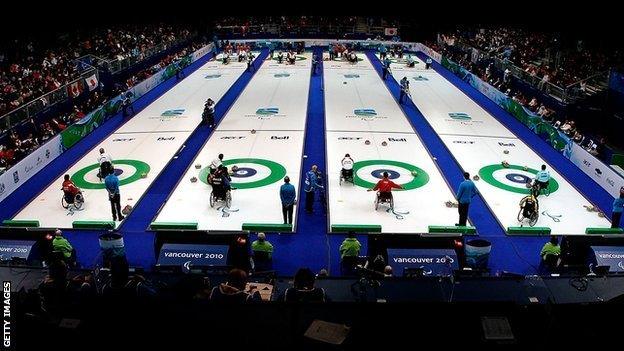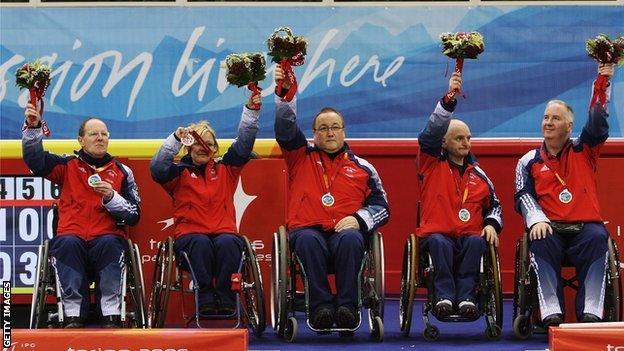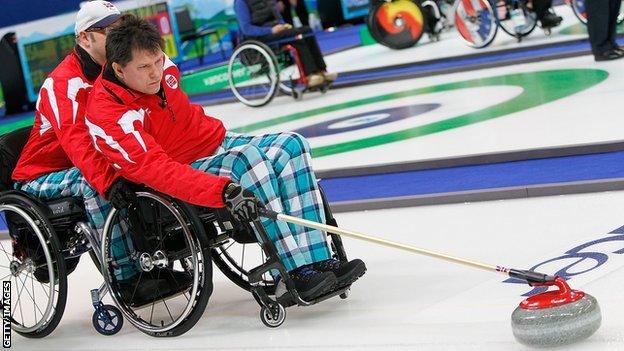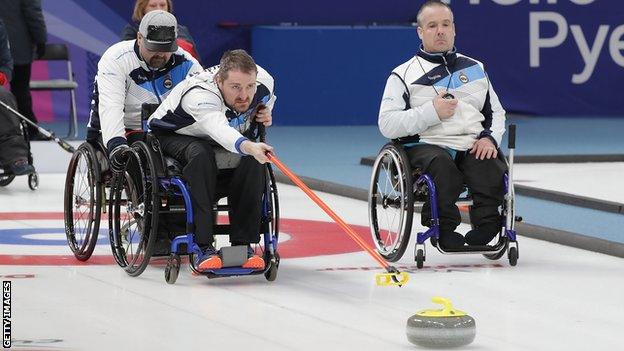Wheelchair curling at the 2018 Winter Paralympics: All you need to know
- Published
Meet ParalympicsGB's wheelchair curling team
Paralympic Games on the BBC |
|---|
Venue: Pyeongchang, South Korea Dates: 9-18 March Time in Pyeongchang: GMT +9 |
Coverage: Follow on Radio 5 live and via the BBC Sport website. Television coverage on Channel 4. |
Wheelchair curling made its Paralympic debut in Torino in 2006.
Teams are comprised of male and female athletes who have a physical impairment in the lower half of their body. This can include spinal-cord injuries, cerebral palsy, multiple sclerosis and double-leg amputation.
The team has four players: Lead, second, third and skip, plus an alternate who can come in as a replacement.
Basic rules
The sport is almost identical to the Olympic version but with one key difference - sweeping is not permitted, meaning the delivery of the stones has to be even more precise.
Twelve teams take part in Paralympic competition. The round-robin phase involves each team playing each other once. At the end, the top four teams qualify for the semi-finals. In the event of a tie, there are tie-breaker matches.
Each match is made up of eight ends.
The object is to slide stones with handles across the ice, aiming for them to come to a stop on a target, called the house, which is marked by four concentric circles. The lead delivers the first stone and the play continues with each athlete delivering two stones alternating with the opposing team (16 stones in total). Placing the stone inside the house means earning a possible point.

The action on the rink is keenly contested
The team which places the most stones closest to the centre of the house wins the point.
When an athlete throws the stone, an athlete of the same team holds the wheelchair so that the wheelchair stays firm.
Although the feet of the player who throws the stone must not come into contact the surface of the ice, the wheelchair wheels must be placed on the surface of the ice.
To throw the stone, athletes may use their arms and hands, or their "delivery stick".

The GB team won silver when the sport made its Games debut in 2006
GB Paralympic history
Sochi 2014
Bronze medal
Team: Aileen Neilson, Gregor Ewan, Bob McPherson, Jim Gault, Angie Malone (alternate)
Vancouver 2010
Seventh
Team: Michael McCreadie, Aileen Neilson, Tom Killin, Angie Malone, Jim Sellar (alternate)
Turin 2006
Silver
Team: Frank Duffy, Michael McCreadie, Angie Malone, Tom Killin, Ken Dickson (alternate)

Norway's hopes will be led by the experienced Rune Lorentsen
Did you know?
Canada are the defending Paralympic champions but six different countries have won medals in the past three World Championships.
Norway are the reigning world champions after beating Russia 8-3 in the final last March. One of the Norwegian stars is skip Rune Lorentsen who has been part of the team since 2006 but is still to win a Paralympic medal.
Scotland (essentially the GB team) won bronze.
The Scottish team were relegated to the B Division in 2015 but earned promotion back to the A Division the following year.

Hugh Nibloe delivers a stone supported by Gregor Ewan and Robert McPherson